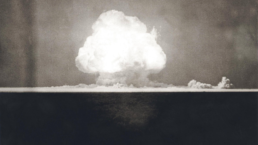So why isn’t it possible to imagine that they will be abandoned, just like other technologies that are dangerous and essentially useless? They could readily go extinct even though the memory of how to make them persists.
By David P. Barash, Transcend Media Service
After seeing the movie, “Oppenheimer,” a friend said, glumly, “I certainly don’t like nukes, but what can we do? We can’t put that genie back in its bottle.” Those of us eager to get rid of nuclear weapons hear this a lot and at first glance it seems true; common sense suggests that we’re stuck with Oppenheimer’s genie because after all, it can’t be disinvented. But this “common sense” is uncommonly wrong. Technologies have appeared throughout human history and just as the great majority of plant and animal species have eventually gone extinct, ditto for the great majority of maladapted technological genies. Nearly always they have simply been abandoned once people recognized they were inefficient, unsafe, outmoded, or sometimes just plain silly.

Don’t be bamboozled, therefore, by the oft-repeated claim by Defense Intellectuals that we can’t put the nuclear genie back in its bottle. We don’t have to. The earliest high-wheel bicycles, called Pennyfarthings, were popular in the 1870s and 1880s. They were not only difficult to ride, but dangerous to fall off.
Between 1897 and 1927, the Stanley Motor Carriage Company sold more than ten thousand Stanley Steamers, automobiles powered by steam engines. Both technologies are now comical curiosities, reserved for museums. Perhaps Transportation Intellectuals warned at the time that you couldn’t put the Stanley Steamer or Pennyfarthing genies back in their bottles.
Technological determinism—the idea that some objective technological reality decides what technologies exist—seems persuasive. After all, we can’t disinvent anything, nuclear weapons no less than Penny-farthings and Stanley Steamers. There are no disinvention laboratories that undo things that shouldn’t have been done in the first place. To say that nuclear weapons will always be with us because they can’t be disinvented is like saying you will always be alive because you can’t be disborn.
Pessimists clinging to the myth of disinvention also argue that nuclear weapons can never be done away with because the knowledge of how to build them will always exist. Inventing something is conceived as a one-way process in which the crucial step is the moment of invention. Once that line has been crossed, there is no going back.
Again, this is superficially plausible. After all, we don’t keep technology around (except sometimes in museums) the way we store knowledge in libraries, textbooks, and cultural traditions.
Bad ideas may persist in libraries, but not in the real world. The physicist, Edward Teller, “father of the hydrogen bomb,” had some bad ideas. He urged, for instance, that H-bombs be used to melt arctic ice in order to dig seaports and also to free up the Northwest Passage, while other physicists, including Freeman Dyson, spent years on Project Orion, hoping to design a rocket that would be powered by a successive series of nuclear explosions. Crappy ideas don’t have to be forgotten in order to be abandoned.
To understand how nuclear weapons might fit this mold, and be eliminated, look at technologies more generally, and how they go away. Venture capitalists, for example, are aware that new things don’t become permanent the moment they’re invented, nor do they disappear because they’ve been disinvented. Technologies have a life cycle whose two end points aren’t birth and death, but invention, then (sometimes) adoption, followed by either modification or abandonment.
This applies to weapons, too. Stone axes didn’t disappear because people couldn’t make them anymore, or because our ancestors ran out of stone. Iron replaced bronze, steel replaced iron; spears, blowguns, bows and arrows, the hand mortar, matchlock rifles, blunderbusses, the gatling gun: Each went extinct because they were superseded and then abandoned, and for good reasons.
And nuclear weapons? Bertrand Russell noted that one can imagine watching a tightrope walker balance aloft for five minutes, or even fifteen, but for a whole year? Or a hundred? Moreover, nuclear weapons have never been very useful, if indeed they have been useful at all, except to benefit those relatively few individuals, civilian and military, whose careers have profited from designing, developing and deploying them.
So why isn’t it possible to imagine that they will be abandoned, just like other technologies that are dangerous and essentially useless? They could readily go extinct even though the memory of how to make them persists.
Yes, nuclear weapons cannot be disinvented or rebottled. Oppenheimer and his colleagues bequeathed us something that was remarkable, not very useful, and very dangerous. One way to facilitate eliminating the danger is to understand that they were never very good technology to begin with. And to recognize that insofar as they are bad genies they needn’t be stuffed back into their bottles. They can be left to fall of their own weight, or, alternatively, to suffer the fate suggested by Brent Scowcroft—no peacenik—when, in retirement, he was asked what should best be done with them: “Let ‘em rot.”
David P. Barash is professor of psychology emeritus at the University of Washington. His most recent book is OOPS! The Worst Blunders of All Time, from Pandora’s Box to Putin’s War.
Recent Posts
The “President Of Peace” Prepares For War
December 23, 2025
Take Action Now The Donroe Doctrine Hits HomeBy William D. Hartung, Tom Dispatch Earlier this month, the Trump administration released its new…
“Who Are They Protecting?”: Rep. Ro Khanna Urges Contempt Charges Over AG Bondi’s Epstein Redactions
December 22, 2025
Take Action Now “The House can act unilaterally on contempt, and this will be introduced by Thomas Massie. What the resolution will say is that…
Dems Demand Answers as Trump Photo Disappears From DOJ Online Epstein Files
December 21, 2025
Take Action Now “What else is being covered up?”By Brett Wilkins, Common Dreams Congressional Democrats on Saturday pressed US Attorney General…
Elon Musk Is Vowing Utopia Driven by AI and Robotics. Bernie Sanders Has a Few Questions
December 20, 2025
Take Action Now “I look forward to hearing about how you and your other oligarch friends are going to provide working people with a magnificent life…




